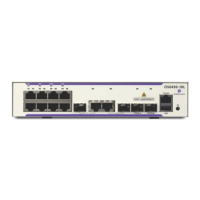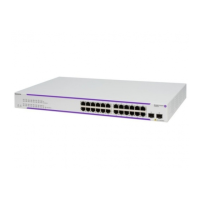OmniSwitch OS6860/OS6900/OS10K Troubleshooting Guide Part No.032996-00 Rev.A
AOS Release 7.X and 8.X January 2015
Alcatel-Lucent Page 73 of 148
In this example, it is not possible to find a single mask to cover port 2, 3 and 4. As a result the switch will
consume 2 TCAM rules.
TCAM entries consumption examples for TCP/UDP port range
Source TCP port 0-10 consumes 3 TCAM rules
Source TCP port 1-10 consumes 5 TCAM rules
Source TCP port 0-32 consumes 2 TCAM rules
Source TCP port 1-32 is supposed to consume 6 TCAM, so 1 hardware TCP/UCP range is used in
combination with only 1 TCAM rule
Source TCP port 0-65535 consumes 1 TCAM rule
Source TCP port 1-65535 is supposed to consume 16 TCAM rules, so 1 hardware TCP/UCP range is
used in combination with only 1 TCAM rule
Example 1: Layer 4 – a single port
Configuration
policy service http destination tcp 80
policy condition c1 service http
policy action a1 disposition accept
policy rule r1 condition c1 action a1
qos apply
Consumes 1 TCAM rule on the NI
Explanation
Single Port: 80 (decimal) -> (binary) 80 = 00000000 01010000
value 00000000 01010000
mask 11111111 11111111
In order to match this value the rule has to do an exact match for port 80
Example 2: Layer 4 – a port range
Configuration
policy condition c1 source tcp 1-2
policy action a1 disposition accept
policy rule r1 condition c1 action a1
qos apply
Will consume 2 TCAM rules on the NI
Explanation
Port Range: 1-2 (decimal) -> (binary) 1 = 00000000 00000001
2 = 00000000 00000010
One single rule is used to match when the port number is equal 1:
TCAM rule 1 value1 00000000 00000001 (match port 1)
mask1 11111111 11111111 (full mask)
Another rule is used to match when the port number is equal 2:
TCAM rule 2 value2 00000000 00000010 (match port 2)
mask2 11111111 11111111 (full mask)
Example 3: Layer 4 – a port range

